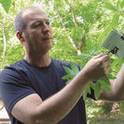The allelopathic potential of Alliaria petiolata is well established in the lab, but questions remain about the importance of these processes in natural settings, partly because we know so little about the stability of the purported allelopathic compounds. We determined the half-lives of several flavonoid glycosides produced by A. petiolata in sterile and non-sterile soil at two temperatures. We also attempted to quantify the levels of the glucosinolates and flavonoid glycosides produced by A. petiolata, in field soils. The flavonoid glycosides had half-lives in non-sterile soil ranging from 3 to12 h. Even in sterile soil the longest half-life was only 45.5 h. None of the glucosinolates or flavonoid glycosides produced by A. petiolatawere detected in bulk soil extracts. Only one compound, isovitexin-6″-O-β-d-glucopyranoside, was detected during nine months of biomimetic soil extraction. These very low field levels and short half-lives suggest that the allelopathic effects of A. petiolata are likely either due to degradates of the compounds produced by the plant, or to other unknown mechanisms.
Available at: http://works.bepress.com/don-cipollini/8/
